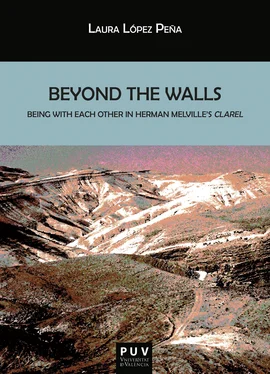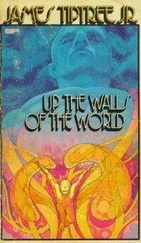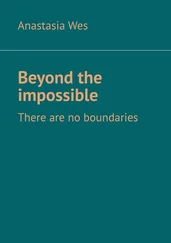Laura López Peña - Beyond the Walls.
Здесь есть возможность читать онлайн «Laura López Peña - Beyond the Walls.» — ознакомительный отрывок электронной книги совершенно бесплатно, а после прочтения отрывка купить полную версию. В некоторых случаях можно слушать аудио, скачать через торрент в формате fb2 и присутствует краткое содержание. Жанр: unrecognised, на английском языке. Описание произведения, (предисловие) а так же отзывы посетителей доступны на портале библиотеки ЛибКат.
- Название:Beyond the Walls.
- Автор:
- Жанр:
- Год:неизвестен
- ISBN:нет данных
- Рейтинг книги:3 / 5. Голосов: 1
-
Избранное:Добавить в избранное
- Отзывы:
-
Ваша оценка:
- 60
- 1
- 2
- 3
- 4
- 5
Beyond the Walls.: краткое содержание, описание и аннотация
Предлагаем к чтению аннотацию, описание, краткое содержание или предисловие (зависит от того, что написал сам автор книги «Beyond the Walls.»). Если вы не нашли необходимую информацию о книге — напишите в комментариях, мы постараемся отыскать её.
Beyond the Walls. — читать онлайн ознакомительный отрывок
Ниже представлен текст книги, разбитый по страницам. Система сохранения места последней прочитанной страницы, позволяет с удобством читать онлайн бесплатно книгу «Beyond the Walls.», без необходимости каждый раз заново искать на чём Вы остановились. Поставьте закладку, и сможете в любой момент перейти на страницу, на которой закончили чтение.
Интервал:
Закладка:
This volume’s approach to Clarel is determined by a conception of Melville’s texts that is influenced by Mikhail Bakhtin’s notions of polyphony, heteroglossia and dialogism. Although Bakhtin refers specifically to the novel (and, more specifically, to Dostoevsky’s novels) in his articulation of polyphony and heteroglossia, and despite the fact that Clarel is a poem, Bakhtin’s theorizations of polyphony and fiction can be applied to the analysis of Melville’s 1876 text. As a matter of fact, Bakhtin himself acknowledges that the significance of polyphonic thinking “extends far beyond the limits of the novel alone” (3). Bakhtin associates polyphony to multivoicedness, defining polyphony as “ [a] plurality of independent and unmerged voices and consciousnesses ” (6), and connecting it to dialogism: “ The polyphonic novel is dialogic through and through ” (40). 3 He conceives signification as a dialogic process that emerges from the interactions of the author, text, and reader, each of them inscribed within their particular social and historical contexts. In this process, Bakhtin claims, the author is not a “monologic” (88) source of meaning but “acts as an organizer and participant in the dialogue without retaining for himself the final word” (72). Bakhtin’s dialogism may be connected to Melville’s “Manysidedness” ( Clarel 3.16.236), a Melvillean term denoting a capacity for plural thinking that stems from the dialogic exposure to, and interaction with, a multiplicity of human beings and/or the worldviews these represent, and which is directly connected to the universalism the poem articulates.
In this respect, Clarel ’s universalism emphasizes the plurality by which it is itself necessarily constructed, as well as the mutual constituency, mutual dependency, and actual inseparability of the particular and the global, blending at the interpersonal level. It is actually at the intersubjective level that the particular and the universal merge by the getting together of two or more individuals who are necessarily different. The difference of these individuals not only lies in their diverse, specific, life-experiences, sociopolitical and economic contexts, and maybe national, ethnic, sexual, etc. identities, but also, and most importantly, in the fact that they constitute different and unique complex subjectivities irreducible to such contexts and identities: both representatives of their particular singularity and complexities and, at the same time, of the larger picture of humanity. Melville’s articulation of universalism is, hence, grounded on intersubjectivity, seemingly in tune with Hannah Arendt’s 1955 remark that “the world […] can form only in the interspaces between men in all their variety” (30-31). The present volume, thus, analyzes how Clarel sets off to portray the democratizing possibilities of this intersubjective creation of “the world” triggering the development of a plural thinking that breaks through the rigid frontiers of one-sided 4 imaginations and community-based worldviews. It is at this interpersonal level, Clarel shows, that ways of thinking and relating, both transcending and challenging egocentric mindsets and behaviors, as well as rigid conceptions of community, might be either developed or completely cancelled.
Also influenced by Bakhtin’s view is the approach to literature of this volume, based on the belief in the necessity to consider literary artifacts as both products of those human beings who created them and of the contexts in which they were produced. This study, therefore, highlights the importance of examining the authorial dimension and the material conditions of literary texts, for, as Dennis Berthold has noted on Melville’s 1876 poem, “ Clarel exists in a particular time and place in its genesis, composition and setting” ( American 231). So are characters “contingent individuals” (232) in that they address issues determined by particular historical, political, social, economic, and personal contexts. This volume, then, considers Melville himself, in his capacity as creator of literary polyphonic spaces, as well as the context in which Clarel is inscribed, valuable sources of information, which are enabling, not limiting, to readerly interpretations past and present. It conceives the reading process as an intersubjective relationship between author, text, and reader (and of readers with other readers), texts themselves “never speaking unless spoken to” (Melville “A Thought” 238).
The present study’s analysis of Clarel is preceded by considerations which are of importance to my interpretation of the poem. Chapter 1 provides an articulation of Melville’s intersubjective universalism from a theoretical perspective. This theoretical articulation is based, on the one hand, on the theoretical possibilities opened up by poststructuralism in its rethinking of individual and collective identities, its problematization of monolithic Meanings, and its avowal of more fluid and plural forms of conceiving human subjectivity and human relationships; and, on the other hand, on the theorizations on community, subjectivity, intersubjectivity, universalism, politics, and ethics by contemporary thinkers such as Arendt, Bauman, Buber, Butler, Derrida, Laclau, Levinas, Nancy, Spivak, or Zerilli, among others. Chapter 2, in turn, offers an analytical overview of Melville’s rejection of cosmopolitanism in his literary production. Most importantly, it exposes Melville’s works’ constant exploration of the potentiality of intersubjectivity to the creation of democratic relationships beyond the walls of individualism and communitarianism, yet the neutralization of such potentiality by human beings determined by their fears, egocentric behaviors, one-sided thinking parameters, and, ultimately, their imperfect natures in which, as Rolfe notes in Clarel , “Evil and good they braided play / Into one cord” (4.4.27-28). The chapter also joins the debate on Melville’s (non-)religiosity or religious views, examining the representation of religious dogma, God and religious feeling in Melville’s works, which, I argue, moves away from a religious view of morality toward a secular conception of ethics. Chapter 3 constitutes an introductory chapter to the book’s analysis of Clarel . It exposes the material conditions in which Clarel was created, together with the significance of Melville’s 1856-57 travel journal for the 1876 Clarel , and the critical reception the poem elicited both at the time of its publication and throughout the 20 thcentury to the present.
After these initial considerations, the volume proceeds to analyze the political dimension of Melville’s 1876 poem. Intended as a general description of Clarel’s universalist project, Chapter 4 provides an overview of the poem’s recurrent images of human beings that are part of larger or smaller crowds yet whose individuality and specificity the text likewise emphasizes and struggles to retain. This chapter also notes Clarel ’s use of walls—both physical and psychological—as central motifs, arguing that the poem moves beyond these dividing barriers so as to articulate a universalist understanding of human beings and humanity that escapes the parameters of community and identity. Chapter 5 turns to the notion of “pilgrimage” for the analysis of Melville’s explicit connection of form and content in the very subtitle of the poem. Examining Clarel ’s depiction of a journey of unlearning by means of the poem’s problematization of fix Meanings, the chapter studies Clarel ’s careful construction of dialogism and plural thinking as mechanisms that develop its universalist project, and how the poem proposes different levels of pilgrimage and pilgrimaging which serve the unlearning journey as they foster independent critical thinking. A central section of Chapter 5 centers on dialogism and the role of dialogue construction (or destruction) in the (non-)de-transcendalization of monologic “Truths” and creation of plural thinking. In particular, I defend the character of Rolfe as an example of a manysided nature, since, unlike other characters, he is capable of continuously intermingling opposites and of an unremitting critical thinking without taking up a (self-)destructive mania. Besides Rolfe, the plural thinker and diver 5 in the poem, the chapter also approaches textual mechanisms by which such plural thinking is constructed (the palm cantos in Part 3) or not developed (the conviviality cantos also in Part 3 of the poem). Eventually, it analyzes how poetics is placed at the service of Melville’s universalist project in Clarel . The following chapter, Chapter 6, provides a more sociopolitical and historical approach to the poem in relation to the particular context of postbellum United States, a context which, I argue, Clarel evokes and evaluates with severity. In this respect, the chapter turns to Battle-Pieces and Aspects of the War , the volume of poems on the U.S. Civil War Melville published in 1866, at the close of the conflict. It claims Battle-Pieces as a continuation of Melville’s universalist project and as a political text conveying some moderate hopes at the close of the war which are completely vanished in Clarel . Thus, the chapter analyzes Clarel as expressive of the disillusionment with postbellum U.S. Melville may have accumulated in the ten years separating the publication of Battle-Pieces and that of Clarel . It regards the poem as a ferocious critique of postbellum American democracy which is interestingly connected to a more global critique of democracy and progress. In this respect, the chapter claims that the poem turns Jerusalem and Palestine into contexts with both specific and global resonances serving Melville’s literary analysis. It also defends that the U.S. is echoed in the Holy Land: Melville exploits the mythical connection between America and the Holy Land only to offer a fierce critique of the myth of exceptionalism, question the construction of both Palestine and the United States as “exceptional” lands favored by the divinity, and problematize the conception of America as “promised land”. The following two chapters center on walls and separation, both physical and psychological, as established by communitarian identity-based formations (Chapter 7) or by individuals (Chapter 8). Focusing on inter- (and also intra-) community divisions, Chapter 7, thus, emphasizes how Palestine acts in the poem as a scenario that serves the purpose of, on the one hand, analyzing segregationism, and, on the other hand, investigating the necessity yet difficulty of transcending such sectarianianism. This chapter particularly approaches religious communities and also nationalism (frequently connected with religion) and gender submission, as well as the suppression of the individual within the community. The chapter ends with an analysis of the poem’s emphasis on gates as connecting spaces, yet also as potential massy walls, and its portrayal of a universal human cry that transcends any existing walls aiming to confine it. Moving from community to inter-personal walls, Chapter 8 analyzes Clarel ’s pilgrimage as an exploration of the possibility or impossibility of interpersonal relationships, and the potentiality of intersubjectivity for the creation of more responsible and democratic interpersonal relationships. Analyzing different instances of egocentrism, monomania and one-sidedness, the chapter focuses on how characters defeat the possibility of intersubjectivity at the very door of togetherness, choosing instead to remain locked in their egocentric natures and, frequently, often (self-)destructive, one-sided, monologic thinking parameters. Finally, Chapter 9 is intended as a conclusion to the volume’s analysis of Clarel . Particularly focused on the final cantos of the poem, the chapter defends that Clarel expresses a painful lament at humans’ failure to materialize universalism and transcend segregationism, individualism, and interpersonal walls. Clarel moves characters (and readers) beyond the oppressive walls of Jerusalem, a city that in the poem becomes symbolic of inter-human walls, and embarks the young Clarel and his fellow travelers (readers included) in a journey through sandy deserts. Also significantly, Melville eventually returns his characters to the oppressive and violently divided walled city of Jerusalem. This decision to end the pilgrimage in Jerusalem may perhaps be indicative of Melville’s painful realization that the interpersonal walls blocking the potentiality of universalism are too well-interiorized by human beings, who continuously undermine their own possibilities of togetherness and perhaps also happiness. By Part 4, the desert has invaded the global city of Jerusalem, now a scenario of universal pain and a city of separate human wails whose actors are deaf to one another’s, of aloneness, and of interpersonal gulfs without bridges. This painful conclusion, however, does not necessarily mean the end of Melville’s belief in the potentiality of intersubjective universalism, which human beings, Melville laments, are too limited, imperfect, selfish, to bring to reality. Despite the difficulty of the task, Melville seems to indicate that the incapacity to participate in its construction neutralizes neither the importance of intersubjective universalism nor its democratizing potentiality. Clarel is an important work to unfold Melville’s lifelong political project, and to give expression to the political voice of the so-called “late Melville”, often considered—when considered—as having no political voice at all.
Читать дальшеИнтервал:
Закладка:
Похожие книги на «Beyond the Walls.»
Представляем Вашему вниманию похожие книги на «Beyond the Walls.» списком для выбора. Мы отобрали схожую по названию и смыслу литературу в надежде предоставить читателям больше вариантов отыскать новые, интересные, ещё непрочитанные произведения.
Обсуждение, отзывы о книге «Beyond the Walls.» и просто собственные мнения читателей. Оставьте ваши комментарии, напишите, что Вы думаете о произведении, его смысле или главных героях. Укажите что конкретно понравилось, а что нет, и почему Вы так считаете.










